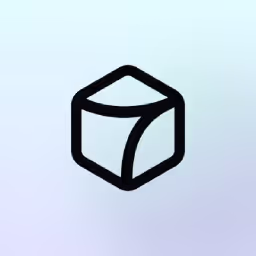Octave Alternatives
An in-depth comparison of 10 Octave alternatives. We analyze MATLAB, Python, R, and others based on features, performance, and cost.

Octave is a popular tool, and for good reason. Many teams use it and find it works well for specific tasks like AI-powered account research. It helps users identify and engage with potential customers, which is why it has a dedicated user base.
However, some users report a steep learning curve and occasional integration issues. If you face these challenges, you may need an alternative. We've analyzed the top options to help you find the right fit for your team. Let's get started.
Explore Digital Workers With 11x
If your goal is to integrate digital workers into your sales efforts, consider 11x. The platform provides autonomous agents designed for specific sales tasks, which lets your team focus on building relationships and closing deals.
11x is a GTM platform where we use AI agents to manage the sales process. One agent, Alice, finds prospects, conducts outreach on email and LinkedIn, and keeps your CRM current.
Another agent, Julian, qualifies inbound leads and books meetings. This setup can replace separate tools for data enrichment, outreach, and email warmup by consolidating them into one platform.
Octave Alternatives
The following section provides a detailed review of the top Octave alternatives. We analyze each tool's pricing, features, and specific pros and cons compared to Octave to help you make a decision.
1) PandaDoc
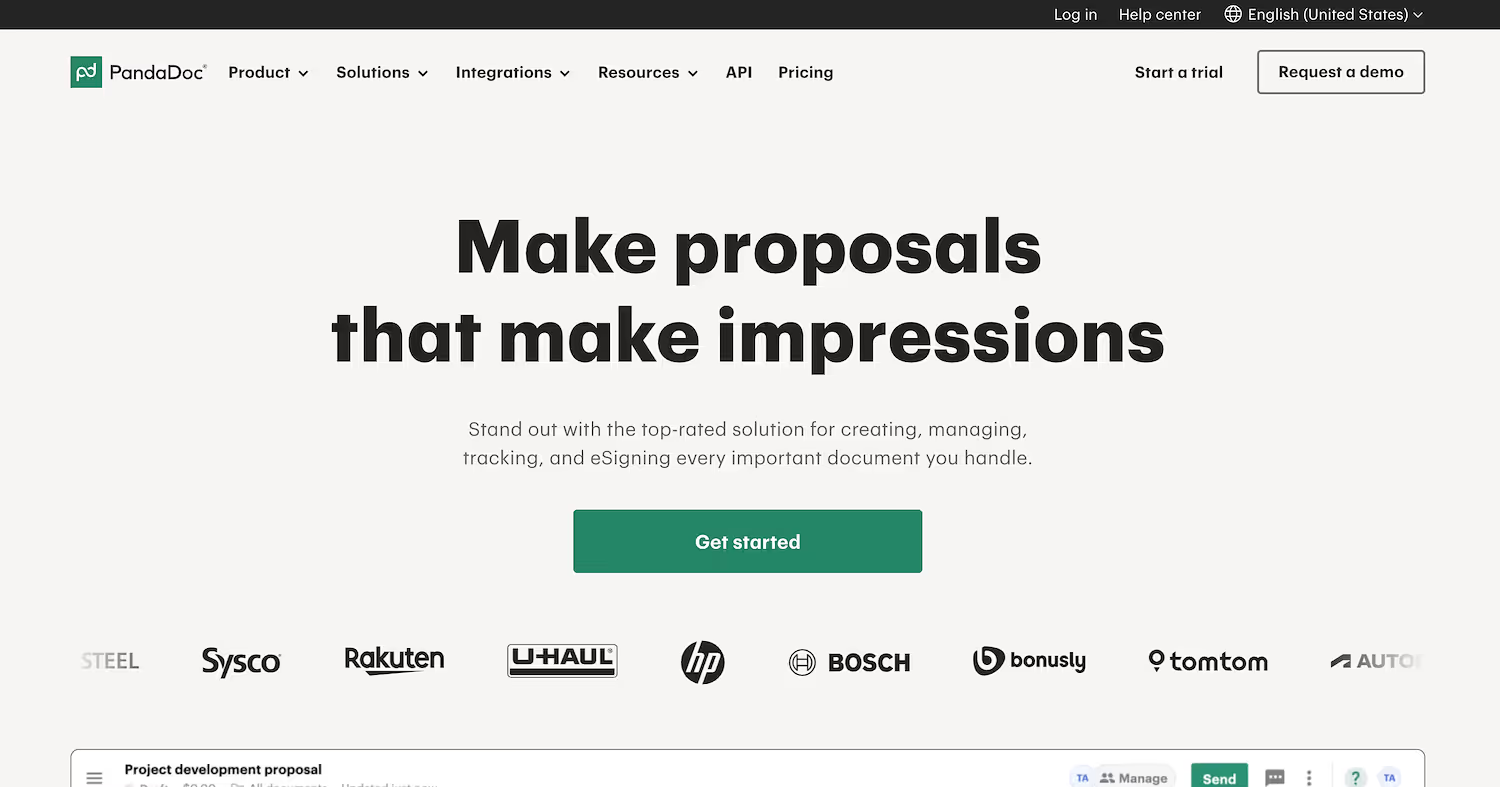
PandaDoc is a platform for agreement management. Teams use it to create, send, track, and eSign business documents. The system covers the entire workflow, from document generation to payment collection.
Its use cases cover sales proposals, contract lifecycle management, and invoices. The platform allows teams to manage the full document process, so they can finalize deals faster and maintain accuracy.
PandaDoc's Main Features
- The platform has a drag-and-drop editor that uses reusable templates to build proposals, quotes, and contracts.
- It offers legally binding eSignatures with options for signing order, signer identity verification, and notarization.
- Users can embed payment gateways like Stripe, Square, and PayPal directly within documents to collect payments.
- Workflow automations can trigger actions, reminders, and internal approvals to reduce manual tasks in the document process.
How PandaDoc Compares to Octave
Average Review score: 4.7/5 stars based on 2,893 G2 reviews.
- PandaDoc provides a full document management system for creation, tracking, and electronic signatures, which is different from Octave's focus on account research.
- It includes legally binding eSignatures and notarization options. Octave does not have features to finalize legal agreements.
- The tool integrates payment gateways into documents to collect payments upon signature. Octave's process concludes before payment collection.
- Its automation manages the document approval process, while Octave automates tasks related to prospect research and outreach.
Where PandaDoc Differs From Octave
- PandaDoc does not provide AI-powered account research tools. This is different from Octave, which helps teams identify and learn about potential customers before outreach.
- The platform is not designed for prospect identification or lead generation. In contrast, Octave automates the process of finding new accounts that fit a company's ideal customer profile.
- It focuses on the final stages of a deal, like proposals and contracts. Octave operates at the top of the sales funnel by helping to build the initial list of target accounts.
Pricing and Cost Analysis
PandaDoc offers an Essentials plan at $19 per user per month and a Business plan at $49 per user per month. A direct cost comparison with Octave is not possible, as Octave does not provide public pricing information.
2) Qwilr
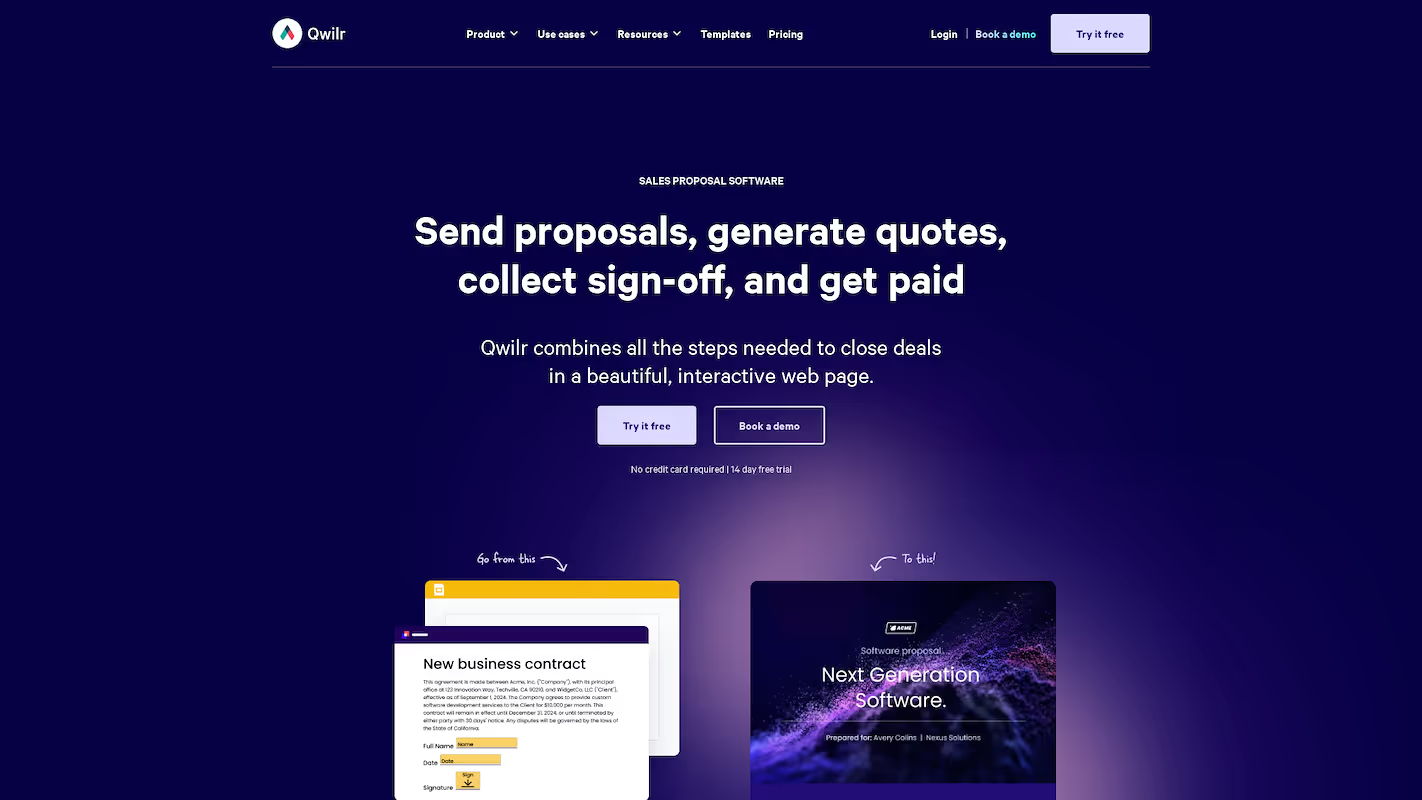
Qwilr is a platform that turns business documents into interactive web pages. Sales teams use it to create, send, and track proposals, quotes, and agreements. The system supports e-signatures and payment collection within a single workflow.
Use cases include document automation, contract management, and digital sales rooms. The product focuses on the proposal and agreement stage of a sales cycle, not initial prospect research.
Qwilr's Main Features
- It has a drag-and-drop editor to build proposals and other collateral without a designer.
- The platform includes interactive quotes with line-item, quantity, and pricing selectors that buyers can adjust.
- It provides analytics and real-time notifications to track who viewed a document and how they engaged with it.
- Users can accept credit card payments directly within a proposal using the QwilrPay feature.
How Qwilr Compares to Octave
Average Review score: 4.6/5 stars based on 802 G2 reviews.
- Qwilr turns sales documents into interactive web pages, whereas Octave focuses on the initial account research phase.
- It includes interactive quotes that allow buyers to adjust pricing options, a feature not present in Octave, which operates before the quoting stage.
- The platform provides detailed analytics on how buyers interact with proposals. This is different from Octave, which provides data on prospect research.
- Users can collect e-signatures and payments directly within a Qwilr page to close deals. Octave does not have features for this final step of the sales process.
Where Qwilr Differs From Octave
- Qwilr does not have AI capabilities for account research. In contrast, Octave provides detailed background information on prospects to prepare sales teams for outreach.
- The platform lacks tools for prospect discovery. Octave, however, automates the search for new accounts that align with a company's ideal customer profile.
- Its features support the final deal stages, such as proposals and agreements. This differs from Octave, which operates at the top of the sales funnel to build initial target lists.
Pricing and Cost Analysis
Qwilr’s Business plan starts at $35 per user per month, while its Enterprise plan is $590 for 10 users. A direct comparison is not possible as Octave does not provide public pricing, which may indicate a custom quote model. For specifics, check Qwilr's official website.
3) Proposify
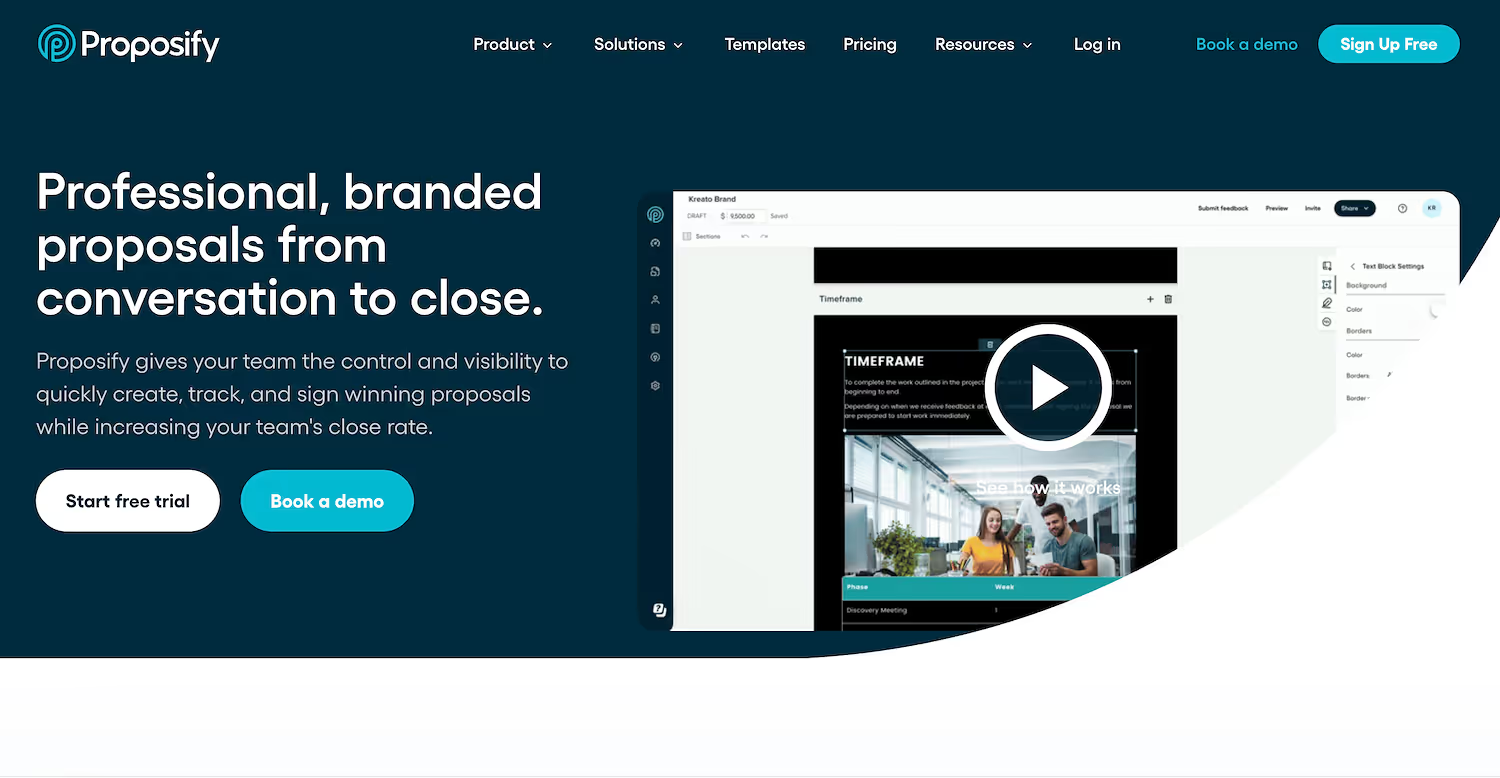
Proposify is a proposal management platform for revenue teams. It allows users to create, send, track, and e-sign proposals, quotes, and contracts. The system gives organizations centralized control and real-time visibility over their documents.
Use cases include sales proposals, statements of work, and contracts. The platform focuses on the document stage of a deal, from creation to signature, rather than top-of-funnel activities like account research.
Proposify's Main Features
- The platform includes a drag-and-drop editor with a centralized content library and reusable templates for creating proposals.
- It provides interactive quoting, which allows prospects to adjust quantities and add-ons directly within the document.
- The system offers real-time engagement analytics, including open notifications and page-by-page time tracking.
- Users can set up automated workflows for tasks like internal approvals, discount triggers, and sending reminders to clients.
How Proposify Compares to Octave
Average Review score: 4.6/5 stars based on 1,122 G2 reviews.
- Proposify offers a system to create, send, and track sales documents, which is different from Octave's focus on initial prospect research.
- It includes legally binding e-signatures to finalize deals. Octave does not have features for this final step of the sales process.
- The tool has interactive quoting, so prospects can adjust options in a proposal. In contrast, Octave's functions are for the pre-proposal stage of sales.
- Its analytics show how prospects interact with sales documents. This differs from Octave, which provides data on the prospects themselves.
- The platform automates internal approval workflows for documents, while Octave automates tasks related to prospect research and initial outreach.
Where Proposify Differs From Octave
- Proposify does not include AI-powered account research. Unlike Octave, teams may need another solution to find detailed background information on prospects before making contact.
- The tool lacks features for prospect discovery. In contrast, Octave automates the search for new accounts that fit an ideal customer profile, which helps build the sales pipeline.
- Its features support the final stages of a deal, like proposals and contracts. This differs from Octave, which operates at the start of the sales process to generate target account lists.
Pricing and Cost Analysis
Proposify offers several pricing tiers, including a Team Plan at $41 per user per month. A direct cost comparison with Octave is not possible, as Octave does not publish its pricing, which likely indicates a custom quote model. For the most current details, check Proposify's official website.
4) DocSend

DocSend is a platform for secure document exchange. Sales teams use it to send proposals, contracts, and other collateral after they identify prospects. The system provides analytics on how recipients interact with the content. This information complements data from AI account research tools, as it shows what happens after the first contact with a potential customer.
DocSend's Main Features
- The platform allows users to share documents through a single, trackable link, with options to revoke access or update content at any time.
- It provides real-time, page-level analytics and view notifications to monitor how recipients interact with shared files.
- The system includes advanced security features like dynamic watermarking, one-click NDAs, and granular permissions for controlled access.
- Users can create virtual data rooms (VDRs) to manage sensitive documents for processes such as due diligence and fundraising.
How DocSend Compares to Octave
Average Review score: 4.6/5 stars based on 529 G2 reviews.
- DocSend provides detailed, page-level analytics on how prospects interact with sales materials. In contrast, Octave provides data about the prospects themselves before outreach.
- It offers advanced security features, such as dynamic watermarking and access revocation, which are not part of Octave's account research functions.
- The platform allows users to create virtual data rooms to manage sensitive documents for due diligence, a function for later deal stages that Octave does not address.
- DocSend's purpose is to securely share and track documents after a prospect is found. Octave's primary role, however, is the initial discovery and research of those prospects.
Where DocSend Differs From Octave
- DocSend does not have a feature for AI-driven account research. This is different from Octave, which gives teams background information on potential customers before the first contact.
- The tool does not help with prospect identification. In contrast, Octave finds new accounts that match an ideal customer profile, a task users must do before using DocSend.
- Its functions support the deal cycle after a prospect is already engaged. Octave, on the other hand, operates at the very beginning of the sales process to generate the initial target list.
Pricing and Cost Analysis
DocSend offers a Personal plan starting at $10 per user per month and a Standard plan from $45 per user per month. A direct cost comparison with Octave is not possible, as Octave does not provide public pricing information.
5) DealHub

DealHub is a sales platform that connects teams and processes. It accelerates the deal cycle with a unified system for quote generation and proposal creation. The platform serves as a central location for sales collateral.
This helps organizations manage interactions from the proposal stage to the final agreement, a different focus from initial account research.
DealHub's Main Features
- Automates complex quoting with a configuration engine, dynamic bundles, and adaptive pricing models.
- Generates contracts dynamically using pre-approved clauses and provides a central repository for them.
- Creates a branded digital sales room for buyer-seller collaboration that includes mutual action plans and chat.
- Manages the subscription lifecycle with automated amendments, flexible billing models, and revenue recognition.
How DealHub Compares to Octave
Average Review score: 4.7/5 stars based on 731 G2 reviews.
- DealHub automates complex quoting with a configuration engine and adaptive pricing. This is different from Octave, which operates before the quoting stage and focuses on account research.
- It provides a digital sales room for buyer-seller collaboration, including mutual action plans. Octave, in contrast, is an internal tool for prospect research and does not have a shared client-facing space.
- The platform generates contracts dynamically from pre-approved clauses and manages their lifecycle. This function addresses the final deal stages, whereas Octave focuses on the initial discovery phase.
- This tool manages the subscription lifecycle with automated amendments and flexible billing. Octave does not handle post-sale activities, as its purpose is top-of-funnel research.
Where DealHub Differs From Octave
- DealHub does not have AI tools for account research. This is a key difference from Octave, which prepares teams with background information on prospects before any outreach.
- The platform lacks features for prospect discovery. In contrast, Octave automates the search for new accounts that match an ideal customer profile, which helps build the sales pipeline.
- Its functions support the final stages of a deal, like proposals and contracts. This differs from Octave, which operates at the start of the sales process to generate initial target account lists.
Pricing and Cost Analysis
DealHub does not provide public pricing, which makes a direct cost comparison with Octave impossible. For the most accurate and up-to-date information, we recommend visiting DealHub's official website.
Automate Your Sales Process With 11x
If you are considering digital workers for your sales team, 11x offers a platform with autonomous agents. They handle tasks like prospect research and outreach, which frees up your team to focus on closing deals. You can explore if this approach fits your strategy.
With 11x, we run your sales playbook with AI. Alice finds accounts, adds data, and handles outreach. Julian manages calls, qualifies prospects, and sets meetings. The platform includes intent signals and email warmup, which replaces other tools in your stack.
Book a demo to see 11x in action.
6) Conga CPQ

Conga CPQ is a platform for sales teams to automate the quote-to-cash process. It helps create accurate quotes for complex products and services. Use cases include sales guidance, price optimization, and proposal creation.
The system focuses on the middle and final stages of the sales cycle, after a prospect shows interest. It does not perform account research or prospect discovery, functions handled by other tools.
Conga CPQ's Main Features
- Automates the quote-to-cash process for sales teams.
- Creates accurate quotes for complex products and services.
- Provides sales guidance to assist with deal configuration.
- Includes price optimization tools to maintain quote accuracy.
How Conga CPQ Compares to Octave
Average Review score: 4.0/5 stars based on 178 G2 reviews.
- Conga CPQ automates the quote-to-cash process for sales teams. This is different from Octave, which focuses on the initial research phase before a quote is necessary.
- The tool creates accurate quotes for complex products using guided selling and configuration rules. Octave does not have features for product configuration, as it operates before the sales proposal stage.
- It includes dynamic pricing and discounting tools to help sales teams maintain margin control. In contrast, Octave provides data on prospects, not on pricing for products or services.
- The platform has a built-in approvals workflow to route quotes for internal sign-off. This automates a later stage of the sales cycle, while Octave automates tasks at the beginning, like prospect discovery.
Where Conga CPQ Differs From Octave
- Conga CPQ does not provide AI-powered account research. This is different from Octave, which gives teams background information on prospects, so users may need a separate tool for initial discovery.
- The platform lacks features for prospect discovery. In contrast, Octave automates the search for new accounts, which means users must complete this top-of-funnel task before using the system.
- It does not include tools for initial prospect outreach. This is a function of Octave, which helps start conversations, so teams might need another platform for email or social media engagement.
Pricing and Cost Analysis
Conga CPQ does not provide public pricing, which makes a direct cost comparison with Octave impossible. For the most accurate and up-to-date information, we recommend visiting Conga CPQ's official website.
7) Salesforce CPQ

Salesforce CPQ is a native Salesforce tool that automates the quote-to-cash process. It helps sales teams create accurate quotes for complex products and services. Use cases include guided selling, price optimization, and proposal generation.
The system focuses on the middle and final stages of the sales cycle. It does not perform account research or prospect discovery, functions handled by other tools.
Salesforce CPQ's Main Features
- It automates the quote-to-cash process for sales teams directly within the Salesforce platform.
- The system provides guided selling to help users configure complex product and service bundles accurately.
- It includes price optimization tools to manage discounts and maintain quote consistency.
- The platform generates proposals and other sales documents from the configured quote data.
How Salesforce CPQ Compares to Octave
Average Review score: 4.2/5 stars based on 1,415 G2 reviews.
- Salesforce CPQ automates the quote-to-cash process for sales teams. This differs from Octave, which focuses on the initial research phase before a quote is needed.
- It provides guided selling to help users configure complex product bundles. In contrast, Octave provides data on prospects, not assistance with product configuration.
- The platform includes dynamic pricing and discounting tools to manage quote accuracy. Octave does not have features for pricing, as its purpose is pre-sales research.
- This tool generates proposals and contracts directly from quote data. Octave's functions conclude before the document generation stage of a deal.
Where Salesforce CPQ Differs From Octave
- Salesforce CPQ does not provide AI-powered account research. This is different from Octave, which gives teams background information on prospects, so users may need a separate tool for initial discovery.
- The platform lacks features for prospect discovery. In contrast, Octave automates the search for new accounts, which means users must complete this top-of-funnel task before using the system.
- It does not include tools for initial prospect outreach. This is a function of Octave, which helps start conversations, so teams might need another platform for email or social media engagement.
Pricing and Cost Analysis
Salesforce CPQ does not provide public pricing, which makes a direct cost comparison with Octave impossible. For the most accurate and up-to-date information, we recommend visiting the Salesforce CPQ official website.
8) HubSpot Sales Hub
HubSpot Sales Hub is a sales software platform that provides tools for the entire sales process. It helps teams manage leads, automate outreach, and close deals within a single system. Its scope is broader than Octave, which focuses on the initial account research and discovery phase.
HubSpot Sales Hub's Main Features
- The platform includes a full CRM to manage contacts, companies, and deals in one place.
- It provides sales engagement tools like email sequences, templates, and call tracking to automate outreach.
- The system offers reporting dashboards to track sales performance and forecast revenue.
- It has built-in CPQ (Configure, Price, Quote) software to create and send professional quotes.
How HubSpot Sales Hub Compares to Octave
- HubSpot Sales Hub is an all-in-one platform that covers the entire sales cycle. This is different from Octave, which specializes in top-of-funnel account research and initial outreach.
- It includes a native CRM for contact and deal management. Octave, in contrast, is a specialized tool that feeds information into an existing CRM.
- The platform provides sales engagement tools like email sequences. Octave uses AI for account research to inform its outreach, which is a different approach to engagement.
- Its features extend to quoting and closing. Octave’s functions are concentrated at the beginning of the sales process, before the proposal stage.
Where HubSpot Sales Hub Differs From Octave
- HubSpot Sales Hub does not have a dedicated AI function for deep account research. This is a primary feature of Octave, which provides detailed background information on prospects.
- Prospect discovery within HubSpot often relies on manual entry or integrations. In contrast, Octave automates the process of finding new accounts that fit an ideal customer profile.
- The platform is a generalist sales tool covering many functions. Octave is a specialist tool designed for the specific task of top-of-funnel account intelligence and generation.
Pricing and Cost Analysis
HubSpot Sales Hub offers several pricing tiers, including a free plan with limited features. Paid plans start at various price points for different team sizes. A direct cost comparison with Octave is not possible, as Octave does not publish its pricing.
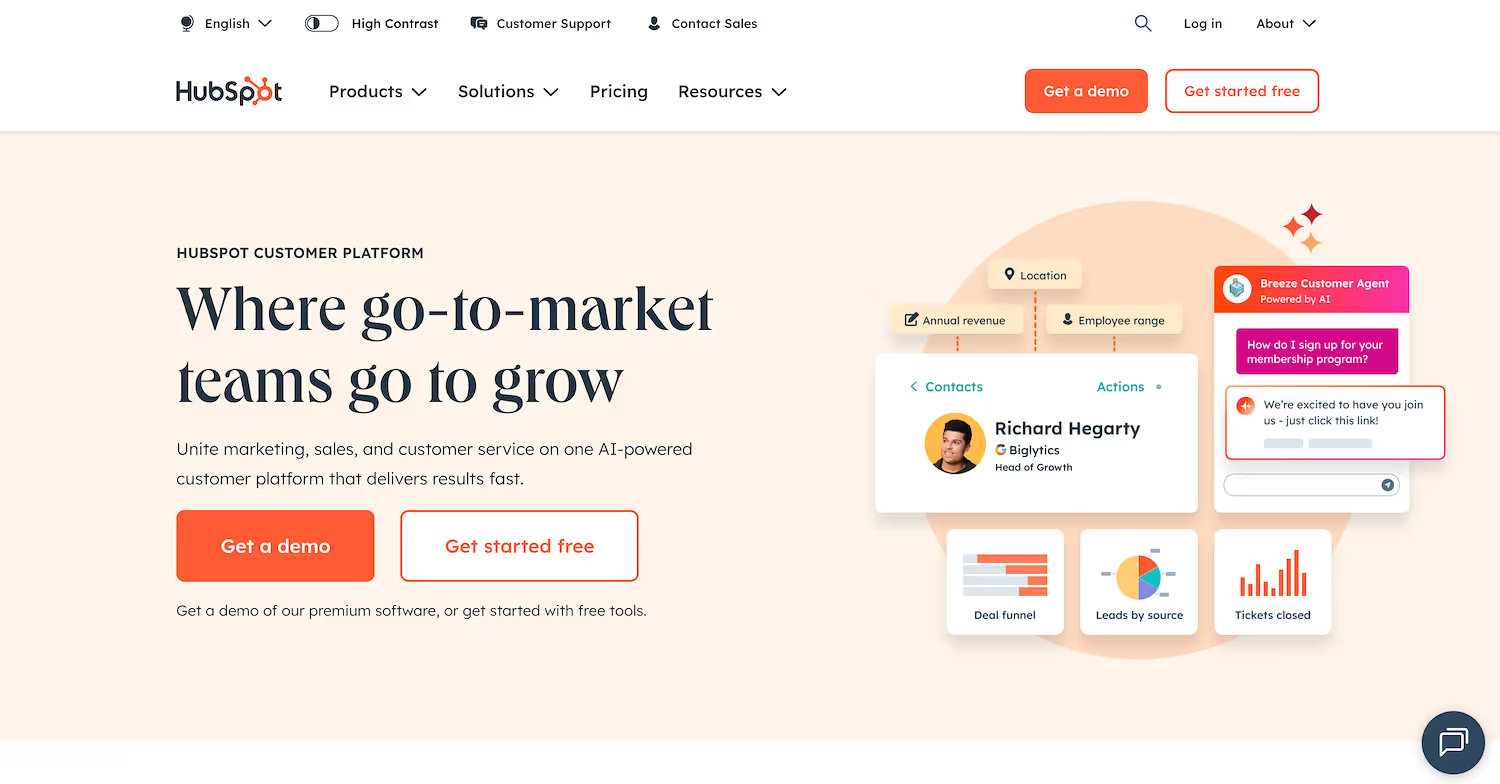
HubSpot Sales Hub is an all-in-one sales platform to manage leads, automate outreach, and close deals. While its scope is broad, it does not have a dedicated AI for deep account research, a primary feature of Octave. This makes it a generalist tool, unlike Octave's specialist focus.
HubSpot Sales Hub's Main Features
- Includes contact and account management functions.
- Provides tools for opportunity and pipeline management.
- Offers marketing automation for email marketing and campaign management.
- Contains customer support features, including case management.
How HubSpot Sales Hub Compares to Octave
Average Review score: 4.4/5 stars based on 12,407 G2 reviews.
- HubSpot Sales Hub provides a complete CRM to manage contacts and deals, which is different from Octave, a specialized tool that feeds data into an existing CRM.
- It includes sales engagement tools like email sequences and call tracking, offering a structured outreach process compared to Octave's focus on initial AI research.
- The platform has built-in CPQ software to create and manage quotes, a function for later in the sales cycle that Octave does not cover.
- This tool offers marketing automation features for running email campaigns, a broader capability than Octave's specific focus on sales account discovery.
Where HubSpot Sales Hub Differs From Octave
- HubSpot Sales Hub does not offer automated AI account research. This is different from Octave, where the system automatically finds deep insights on prospects. Some teams may find they still need to perform this research manually.
- It requires users to find and import their own prospects. This differs from Octave, which automatically builds new target account lists. This might mean more initial setup work to build a pipeline.
- The tool is an all-in-one platform, so its features for initial prospect research are not as deep. In contrast, Octave is a specialist tool, which can sometimes provide more detailed results for that specific job.
Pricing and Cost Analysis
HubSpot Sales Hub offers several pricing tiers, including a free plan and paid options starting at $20 per user per month. A direct cost comparison with Octave is not possible, as Octave does not publish its pricing, which likely indicates a custom quote model.
9) QuoteWerks
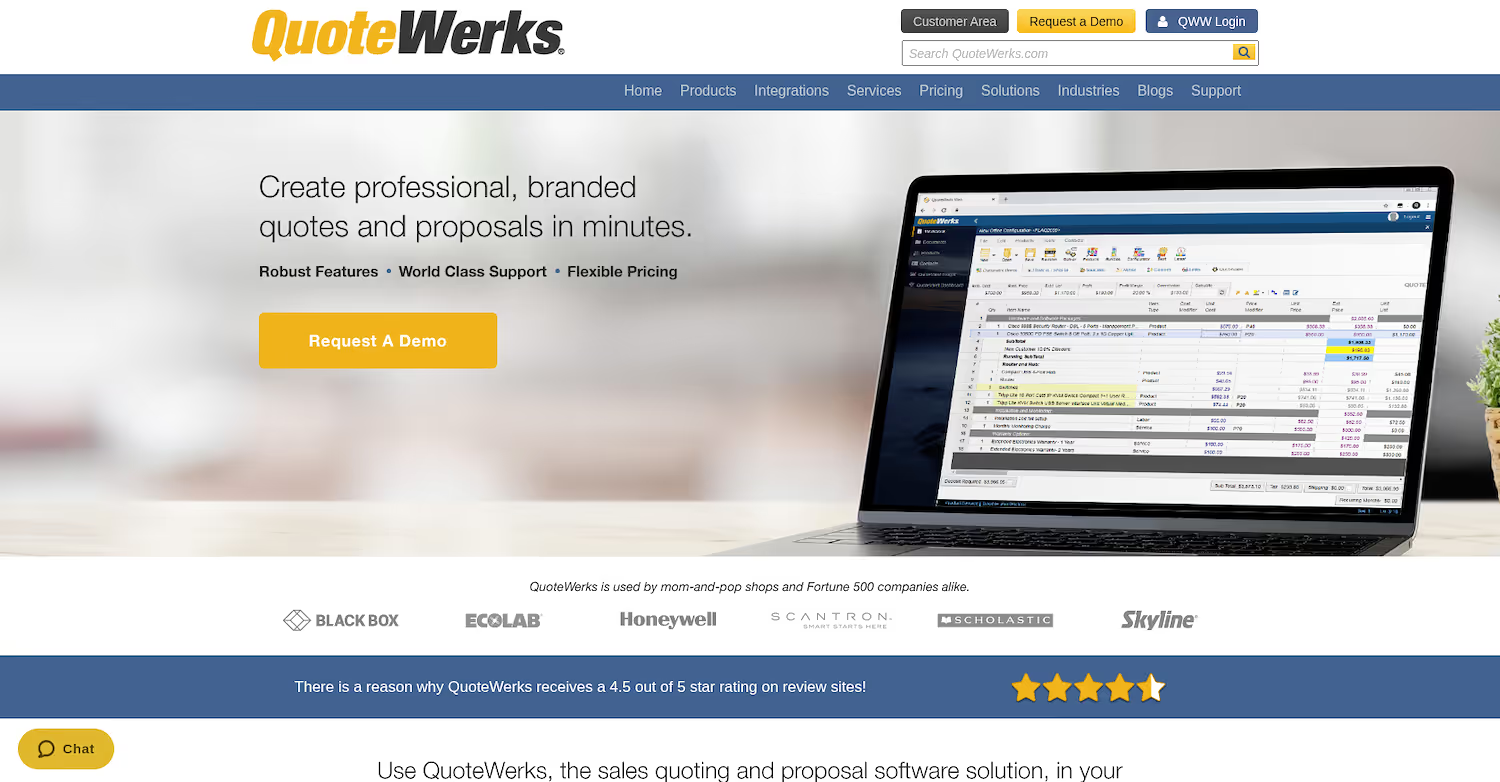
QuoteWerks is a platform for sales quotes and proposals. Teams use it to create, send, and manage these documents. Use cases include quote generation and order management.
The system focuses on the middle stages of the sales cycle. It does not perform account research or discovery, which are functions of tools like Octave. This makes it a tool for tasks after the initial prospect contact.
QuoteWerks's Main Features
- Integrates with over 55 applications for CRM, accounting, and distribution, including Salesforce and QuickBooks.
- Connects to distributors like Tech Data and Ingram Micro for real-time pricing and warehouse availability.
- Provides a step-by-step configurator to build quotes with product bundles and kits.
- Includes an add-on for electronic signatures, payment collection, and quote view tracking.
How QuoteWerks Compares To Octave
Average Review score: 4.3/5 stars based on 182 G2 reviews.
- QuoteWerks connects with distributors like Tech Data for real-time product pricing. This differs from Octave, which provides prospect data but has no links to supply chain information.
- It includes a step-by-step configurator to build complex quotes. In contrast, Octave does not have quoting features because it focuses on initial account discovery.
- The platform collects payments directly within a proposal through an add-on. This function handles the final step of a sale, a stage Octave does not cover.
- An add-on for electronic signatures helps finalize agreements. Octave's process ends before the contract signing stage, as its main job is prospect research.
Where QuoteWerks Differs From Octave
- QuoteWerks does not provide automated account research. Unlike Octave, it does not generate background information on prospects, which means teams may need to perform this task with another solution before creating a quote.
- It does not include a function to find new prospects. Octave automates this search for accounts that fit an ideal customer profile, a task users must handle before they can use QuoteWerks.
- The tool is not designed for initial outreach to prospects. Octave helps start conversations with potential customers, so teams might need a separate platform for email or social media campaigns.
Pricing and Cost Analysis
QuoteWerks offers several plans, with its Standard Edition starting at $15 per user per month. A direct cost comparison with Octave is not possible, as Octave does not publish its pricing, which likely indicates a custom quote model.
10) Zuora CPQ
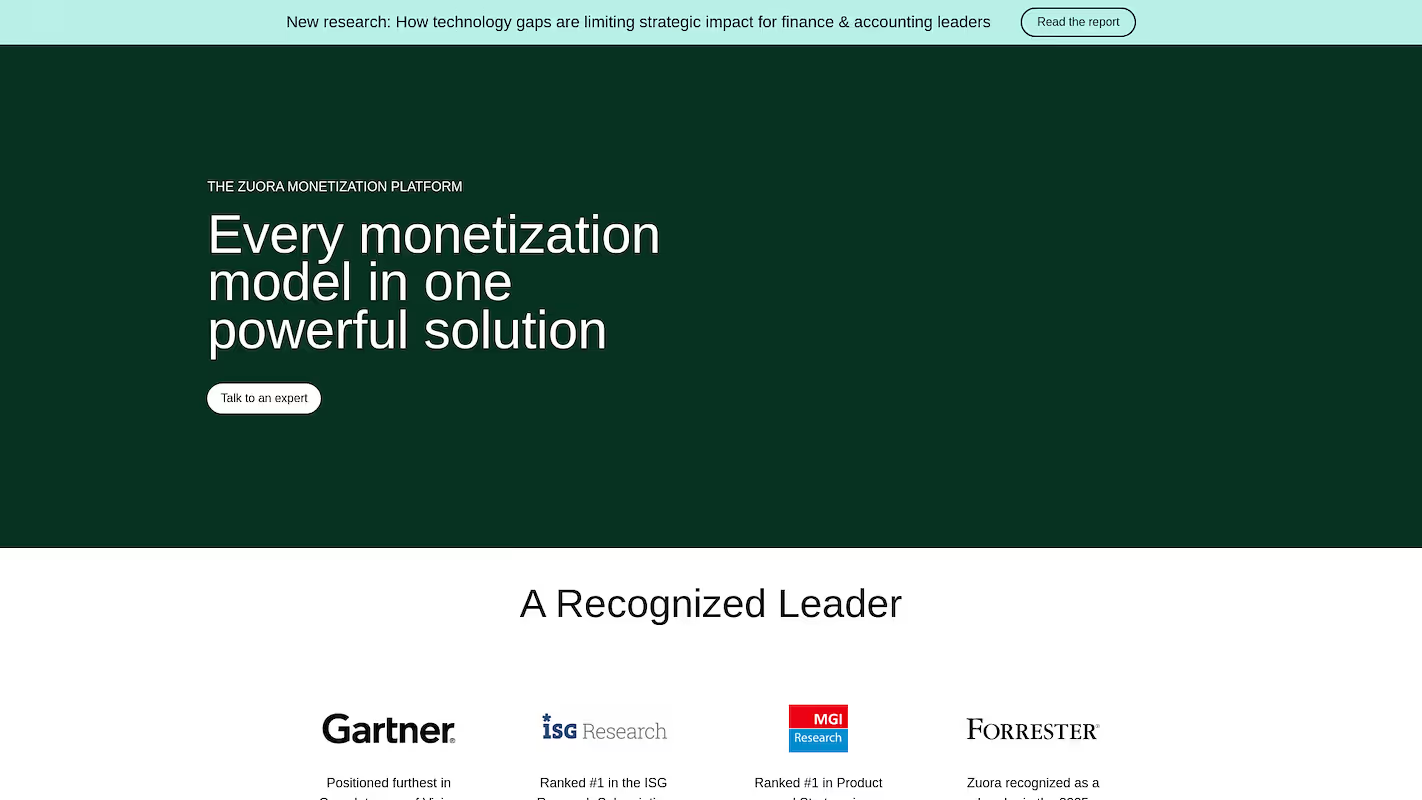
Zuora CPQ is a platform for sales teams to automate the quote-to-cash process. It helps create accurate quotes for complex products and services. Use cases include sales guidance, price optimization, and proposal creation.
The system focuses on the middle and final stages of the sales cycle, after a prospect shows interest. It does not perform account research or prospect discovery, which are functions of other tools.
Zuora CPQ's Main Features
- Automates billing operations with features for prorations, provisioning orchestration, and general ledger integration.
- Supports monetization with over 50 out-of-the-box pricing models, including usage-based and subscription bundles.
- Manages configurable discounting and billing triggers to adapt to different sales strategies.
- Integrates with over 40 payment gateways and provides connectors to tax engines.
How Zuora CPQ Compares To Octave
Average Review score: 3.9/5 stars based on 304 G2 reviews.
- Zuora CPQ automates billing operations with features for prorations and provisioning. This is different from Octave, which automates tasks at the start of the sales funnel, like prospect research, and does not handle billing.
- It supports over 50 pricing models, such as usage-based and subscription bundles. In comparison, Octave provides data on prospects and does not have features to create product pricing structures.
- The platform integrates with more than 40 payment gateways to process customer transactions. Octave's functions end before the payment stage, as its focus is on initial prospect discovery.
- This tool manages the subscription lifecycle with features for plan changes and adjustments. Octave operates at the top of the sales funnel and lacks tools for post-sale subscription management.
Where Zuora CPQ Differs From Octave
- Zuora CPQ does not offer AI-powered account research. Unlike Octave, it does not provide background information on prospects. This means teams may need a separate tool for initial discovery before they can create a quote.
- The platform lacks features for prospect discovery. Octave automates the search for new accounts, so users must find their own leads before they can use Zuora CPQ to generate a quote.
- It does not have tools for initial prospect outreach. Octave helps start conversations with potential customers, so some teams might need a separate platform for email or social media campaigns.
Pricing and Cost Analysis
Zuora CPQ does not provide public pricing, which makes a direct cost comparison with Octave impossible. For the most accurate and up-to-date information, we recommend visiting Zuora CPQ's official website.
Which One Should You Go With?
Choosing the right Octave alternative depends on your team's specific needs and sales process. This guide analyzed several options to help you find a suitable replacement for your workflow.
If your goal is to use digital workers for sales tasks, 11x offers autonomous agents. They handle prospect research and outreach, which allows your team to focus on closing deals and building relationships.




